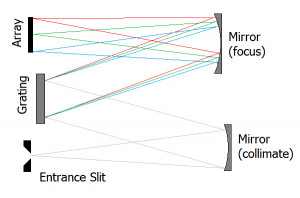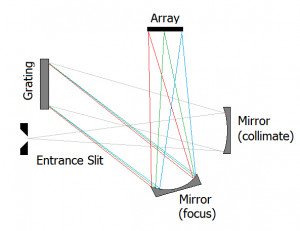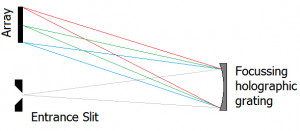3.1 Setup of a Spectroradiometer
A variety of optical designs are used for spectroradiometers. The following are the three most commonly used designs in light measurement engineering:
Czerny-Turner setup
In a Czerny-Turner setup, light enters through the entrance slit and is collimated via a mirror towards an optical diffraction grating. It is then decomposed spectrally and sent in parallel rays towards a focusing mirror. This mirror images the spectrally decomposed rays on the detector array. In principle, this is equivalent to the creation of an image of the entrance slit onto the array or the outlet slit through an additional spectral decomposition via the optical grating in the parallelized optical path.
The angle of the optical elements relative to one-another is used to dimension the spectrometer; this helps reduce aberration effects among other things. If only one mirror is used for collimating and focusing instead of two separate mirrors, the setup is called an Ebert setup.

Fig. 1: Czerny-Turner monochromator
Crossover Czerny-Turner monochromator
The crossover Czerny-Turner monochromator aims at an improved optical path, i. e. a reduction of aberration effects. It also enables construction of more compact spectrometers.

Fig. 2: Crossover Czerny-Turner monochromator
Direct imaging using a curved holographic grating
Special production processes can be used to come up with holographic gratings that enable direct imaging. This helps reduce the required optical elements and hence simply the beam path. It is however limited in the sense that such gratings have to be specifically designed for each application thus reducing their flexibility. In addition, the production costs are enormous.

Setup with a focusing holographic grating
Fig. 3: Setup with a focusing holographic grating
Usually an entrance optic, like a cosine diffuser for spectral irradiance, is mounted on the spectrometer unit. This together with the radiometric calibration makes the spectroradiometer out of the spectrometer. A wavelength calibration is already applied for the spectrometer.